A smart speaker is above all a personalized voice assistant that can really help you in your daily life. This object indeed hosts an artificial intelligence, which is called Alexa, Ok Google or Siri. And which will allow you to control the connected equipment in your home, order your shopping, inform you or entertain you.
Are smart speakers underutilized?
More than simple speakers, these voice-activated assistants allow you to ask aloud for information, listen to music, hear the latest news flash or easily access your agenda, for example. Above all, these voice assistants make it easy to control the house, from its security to heating and lighting, for example, but also the management of its household appliances. Distributed in the house, they can even for some, play the role of interior intercom in order to communicate with the different members of the family in the different rooms of the home.
The multiplicity of uses offered by these smart speakers, on the other hand, is often little exploited, their owners sticking to using them to search for information or quite simply to listen to music. Limited uses that can even encourage them to abandon them little by little while the artificial intelligence specific to these objects of a new kind allows them to update themselves and regularly increase their skills.
Buying the right smart speaker
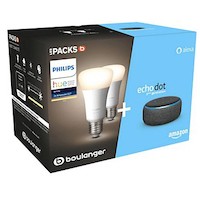 Good to know
Good to know
The speakers are used to control connected devices such as household appliances, lights, televisions, shutters, etc.
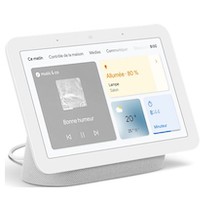 Good to know
Good to know
Some models have a screen, such as Google’s Nest or Amazon’s Echo Show models
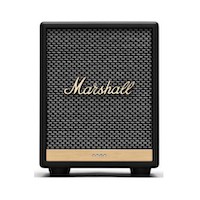 Good to know
Good to know
Do not confuse smart speaker, with a voice assistant, and a connected speaker, which only broadcasts music.
A voice assistant, it’s about but what?
A smart speaker is by definition a voice-activated assistant, linked to an artificial intelligence platform. As a result, this intelligence interprets our requests and provides us with an answer, the exchange taking place in natural language. The most common platforms are Google Assistant, Alexa developed by Amazon or Siri from Apple. Once your smart speaker has been put into service with its dedicated application, entered on your phone, and connected to wifi, all you have to do is call out its nickname. Ok Google, what is the weather forecast for tomorrow? Siri, I want to listen to Leonard Cohen, Alexa, start a 3 minute egg timer, etc.
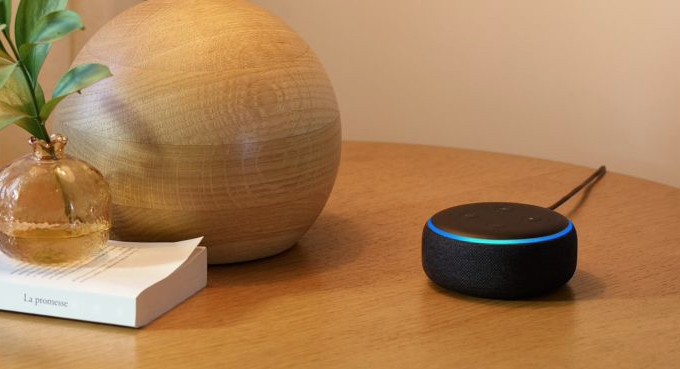 Amazon Echo
Amazon Echo
Amazon, Google, Apple: what are the differences?
Voice assistants today come in a variety of sizes and formats, with some even incorporating screens.
As for the Google Assistant, the first speaker in the classic format, the famous Google Home made it possible from 2017 to popularize the principle of smart speaker in France. Since then, Google has developed its range, now called Nest, which offers different formats. But all of them work with the same voice assistant, namely Google Assistant to respond to your requests for information, stream music and control connected household devices by voice and even create scenarios at your leisure depending on Google Assistant compatible devices.
At around 50 euros, the cheapest and smallest in size is Nest mini, a small pebble that does not prevent it from being a real personal assistant, effective by voice and managing connected devices such as lighting, closing the shutters or switching on the television. Of course, it broadcasts music even if the audio volume will not be large, but given its price, it can be multiplied in each room of the house to broadcast music in multirooms, each speaker being combined in a group to simultaneously stream the music. This little Nest will allow you to start the experience of artificial intelligence at your service in the house for a very reasonable cost. The Nest Audio with the same features offers much greater sound reproduction given its size,
Amazon has declined its Echo range working with its artificial intelligence platform Alexa, on the same principle, namely a medium-sized speaker and its small format version.
The Echo range was the first smart speaker marketed in the United States before arriving here. The new generation with a neat curvilinear design is matched for the Echo speaker with a LED light ring. As a bonus, it offers Dolby sound processing and above all benefits from a smart home hub that supports protocols such as Zigbee. However, this funny name will be all the more useful to you, for example, if you have just installed roller shutters, most of which operate on Zigbee. Clearly, you won’t ask yourself any questions, Echo will manage the opening and closing at your request without having to use any remote control. Its mini version, the Echo Dot shares the same voice assistant functions with the addition of the discreet display of a digital clock,
On the Apple side, the latter was the first manufacturer to develop its voice assistance platform with Siri, which iPhone enthusiasts discovered with enthusiasm on their smartphone in 2011. The brand with the small apple, however, arrived late on the market for smart home speakers. Apple thus marketed the HomePod in 2018, distinguished by significant audio power but also with a very expensive price compared to its competitors Echo and Google Home.
Another major constraint, Apple’s smart speaker only worked with Apple devices. In summary, it was not possible to listen to music streaming services other than iTunes and just as it was not possible to interact with smartphones running for example on Android. Its marketing was stopped last March, leaving room only for its little sister, the HomePod Mini. The latter is a little more open to other ecosystems than the Apple universe and can thus manage a greater number of connected home services and equipment provided it operates on the Thread wireless communication protocol.
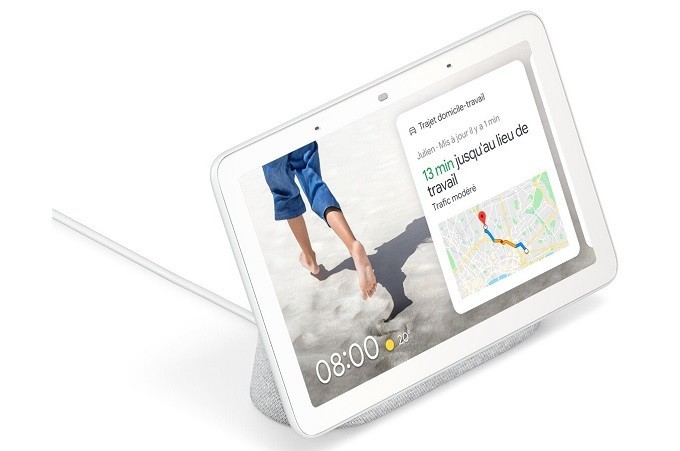 Google Nest
Google Nest
Sound and design, not all are the same
Both Google and Amazon have enriched their ranges by adding additional media to their voice assistant. Amazon offers Echo Show 10 with a 10-inch screen and a panoramic camera. The key is the possibility of communicating directly by video with your interlocutor but also following your favorite series while cooking, or even directly watching a cooking demonstration by a chef. The same is true for the Nest Hub with its screen which allows you to exchange with your contacts on video or watch clips on Youtube. The Nest Hub, installed on your bedside table, will also help you fall asleep with relaxing sounds and wake you up gently since it incorporates a dawn simulator on its 7-inch screen.
The declination of speakers in large and small sizes ensures a multiplication of personal assistants in different rooms of the house. Advantage ? Set up a multiroom system to share the music in each of the rooms as we have seen, but also transform all the speakers into a family intercom. Residents of large houses no longer need to bawl on the stairs to warn the whole family that the meal is ready in order to join everyone at the table. Each speaker can thus be combined in a group intercom system in order to broadcast the same audio message in the household.
Classic format smart speakers had a defect in audio quality when they were launched. Major audio brands like Sony or JBL have not missed the boat by partnering with artificial intelligence platforms such as Google, Amazon or Apple. High-end Hifi specialists such as Bose or Klipsch now also offer smart speakers integrating a voice assistant. The key is sound clarity and power that will convince audio purists.
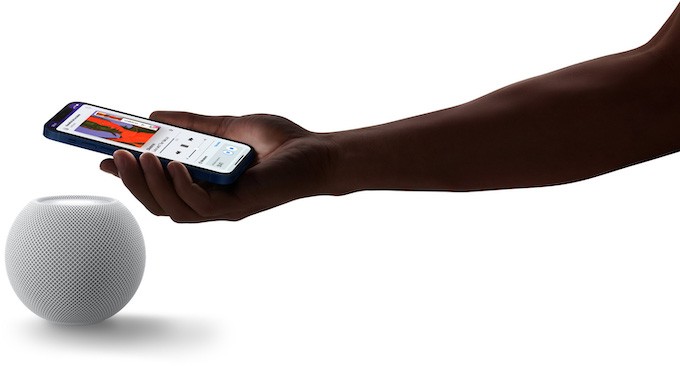 HomePod mini Apple
HomePod mini Apple
A resident butler
Everyday tasks like turning off the lights upstairs, lowering the temperature in the guest room, checking the cooking of the lamb in the oven may be simple but time-consuming. You will no longer have to get up from your sofa, or even interrupt your work to perform these small restrictive gestures. All you have to do is call your voice assistant to carry out these tasks for you, just as it will remind you of your appointment for the day, entered in your agenda.
These personal assistants integrated into smart speakers, it will be understood, are indeed able to interact and control other connected devices. To do this, simply interconnect your new devices such as connected light bulbs, your connected television, your thermostat or your surveillance camera via the dedicated application. Even better, you can create personalized scenarios to wake up the whole house in the morning by starting the music, triggering the lights and opening the shutters while the coffee is automatically prepared in the machine previously placed in a connected socket. And if you notice the lack of butter for breakfast sandwiches,
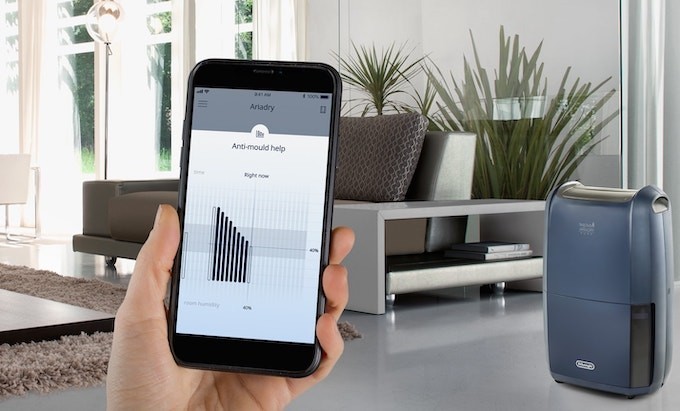 DeLonghi connected purifier
DeLonghi connected purifier
In the kitchen and in household appliances, the voice assistant is developing
Artificial intelligence is nested in many household appliances, starting with the kitchen. Large household appliances now incorporate a number of technologies, but also artificial intelligence with regard to certain models. These devices becoming connected can even be controlled by voice. Some manufacturers have thus developed partnerships with artificial intelligence platforms in order to offer their users intelligence to improve the ease of use of their oven, for example. Once a roast meat is in the oven, all you have to do is choose a recipe on the screen of your oven or via the dedicated application. Google Home on alert will follow the cooking launched precisely by the oven according to the weight of the piece of meat,
Refrigerators have also become a compendium of technology serving the freshness of food but also the management of your stocks. For the time being, communication goes through a touch screen and a connection via the user’s mobiles, but the voice interface controlled by an “in-house” voice assistant is gradually being added to. Evidenced by Samsung’s connected refrigerator, integrating the manufacturer’s own voice intelligence platform, Bixby. The intelligence of the latter is however still limited compared to specialists like Google Assistant, Alexa, and Siri.
Voice assistance has also gradually developed in small household appliances.
The connected food processors available today already simplify your daily culinary life by preparing and cooking small dishes in no time at all. A certain number offer recipes on their screen connected to WIFI but are also managed by applications such as Home Connect. However, the latter is compatible with voice assistants such as Alexa. The key is the possibility of remotely starting the connected cooking robot and displaying from your sofa the recipes offered by the cooking robot in question. Once the dish has been chosen with its list of necessary ingredients, listed by your personal assistant, the latter can even establish a shopping order for the missing ingredients.
On the side of small household appliances, we do not forget cleaning equipment, starting with robot vacuum cleaners. Many are equipped with applications associated with personal assistants. They can thus integrate your personalized scenario. For example, once you have left for work and the smart locks of your home are automatically closed and the temperature of the home is lowered, the robot then begins its work autonomously within the home.
Here are as many illustrations of the functionalities of voice assistants. Resolutely at your service, it would be a shame to limit their use to broadcasting music, the latest news flash or a request for basic information. Better yet, multiplied within the home, you will transform them into as many multiroom speakers but also intercom.
